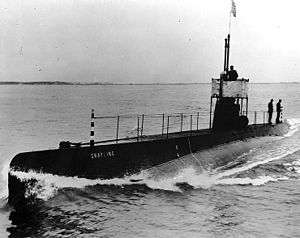USS D-2 (SS-18)
 Grayling, probably during builder's trials, circa 1909 | |
| History | |
|---|---|
| Name: | USS D-2 |
| Builder: | Fore River Shipbuilding, Quincy, Massachusetts |
| Launched: | 16 June 1909 |
| Commissioned: | 23 November 1909, as USS Grayling |
| Decommissioned: | 18 January 1922 |
| Renamed: | USS D-2, 17 November 1911 |
| Fate: | Sold for scrap, 25 September 1922 |
| General characteristics | |
| Class and type: | D-class submarine |
| Displacement: | 288 long tons (293 t) |
| Length: | 134 ft 10 in (41.10 m) |
| Beam: | 13 ft 11 in (4.24 m) |
| Draft: | 11 ft 8 in (3.56 m) |
| Speed: | 13 knots (24 km/h; 15 mph) |
| Complement: | 15 officers and men |
| Armament: | 4 × 18 in (460 mm) torpedo tubes |
USS D-2 (SS-18) was a D-class submarine of the United States Navy. Her keel was laid down by Fore River Shipbuilding Company in Quincy, Massachusetts, under a subcontract from Electric Boat Company of Groton, Connecticut, as Grayling, making her the first ship of the U.S. Navy to be named for the Arctic grayling, a fresh-water game fish closely related to the trout. Grayling was launched on 16 June 1909, sponsored by Miss C. H. Bowles, and commissioned on 23 November 1909 with Lieutenant Owen Hill in command. She was renamed D-2 on 17 November 1911.
Service history
D-2 joined the Atlantic Torpedo Fleet as Flagboat for Submarine Division 3 (SubDiv 3). Along the United States East Coast, D-2 joined in diving, torpedo, and experimental exercises. She participated in the Presidential Review of the Fleet in the North River at New York City from 5 to 18 May 1915.
While patrolling outside Naval Station Newport, Rhode Island, just three nautical miles east of Point Judith shortly before 14:00 on 7 October 1916, D-2 discovered the Imperial German Navy submarine SM U-53 under the command of Hans Rose heading towards Newport, Rhode Island, as part of her hitherto unprecedented two-way traversal of the Atlantic Ocean without refueling or resupply. The United States was still neutral in World War I, but there was an initial flurry of activity when U-53 suddenly steamed away to port believing the submerged D-2 to be a British submarine, but when D-2 surfaced so that a crewman could run aft to raise the United States flag, U-53 slowed. Lieutenant G. C. Fulker, USN, commanding officer of D-2, brought his submarine up close to U-53 on a parallel course to escort U-53 while in sight of land. As the submarines reached the Brenton Reef Lightship, Rose requested permission from D-2 to enter port at Newport. Fulker granted it, and Rose called back by megaphone, "I salute our American comrades and follow in your wake."[1]
After the United States entered World War I on the side of the Allies on 6 April 1917, D-2 served in training and experimental work at New London, Connecticut. On 14 September 1917 she sank at pierside with all hands aboard, although her entire crew was rescued. She was refloated, repaired, and returned to service.
D-2 was placed in commission, in reserve, at the Philadelphia Navy Yard in Philadelphia, Pennsylvania, on 9 September 1919 and placed in ordinary on 15 July 1921. She was decommissioned on 18 January 1922 and sold as a hulk on 25 September 1922.
References
- ↑ Herzog, Bodo & Schomaekers, Günter, Ritter der Tiefe Graue Wölfe, Die erfolgreichsten U-Boot-Kommandanten der Welt des Ersten un Zweiten Weltkrieges, Verlag Welsermühl München-Wels, 1965, pp. 178–9.
- This article incorporates text from the public domain Dictionary of American Naval Fighting Ships. The entries can be found here and here.
External links
- Photo gallery of USS Grayling/D-2 at NavSource Naval History